MARIANI’S
November
2, 2008
NEWSLETTER

North Korean Poster entitled
“Let’s extensively raise goats in all families!”
from the David Heather Collection
NEW! Click esquire.com
to go to my new column at Esquire
Magazine.
ARCHIVE: Readers may now access
an
Archive of all past newsletters--each annotated--dating back to July,
2003, by simply clicking on www.johnmariani.com/archive
SUBSCRIBE AND
UN-SUBSCRIBE: You may subscribe anyone you wish
to this newsletter--free of charge--by
clicking here.
In
This Issue
NEW YORK CORNER: Aureole 20 Years Later by John Mariani
NOTES FROM THE SPIRITS LOCKER: Añejo Tequilas Make Better Margaritas
by John Mariani
QUICK BYTES
~~~~~~~~~~~~~
THE GRANDEUR
THAT IS ROME
by John Mariani
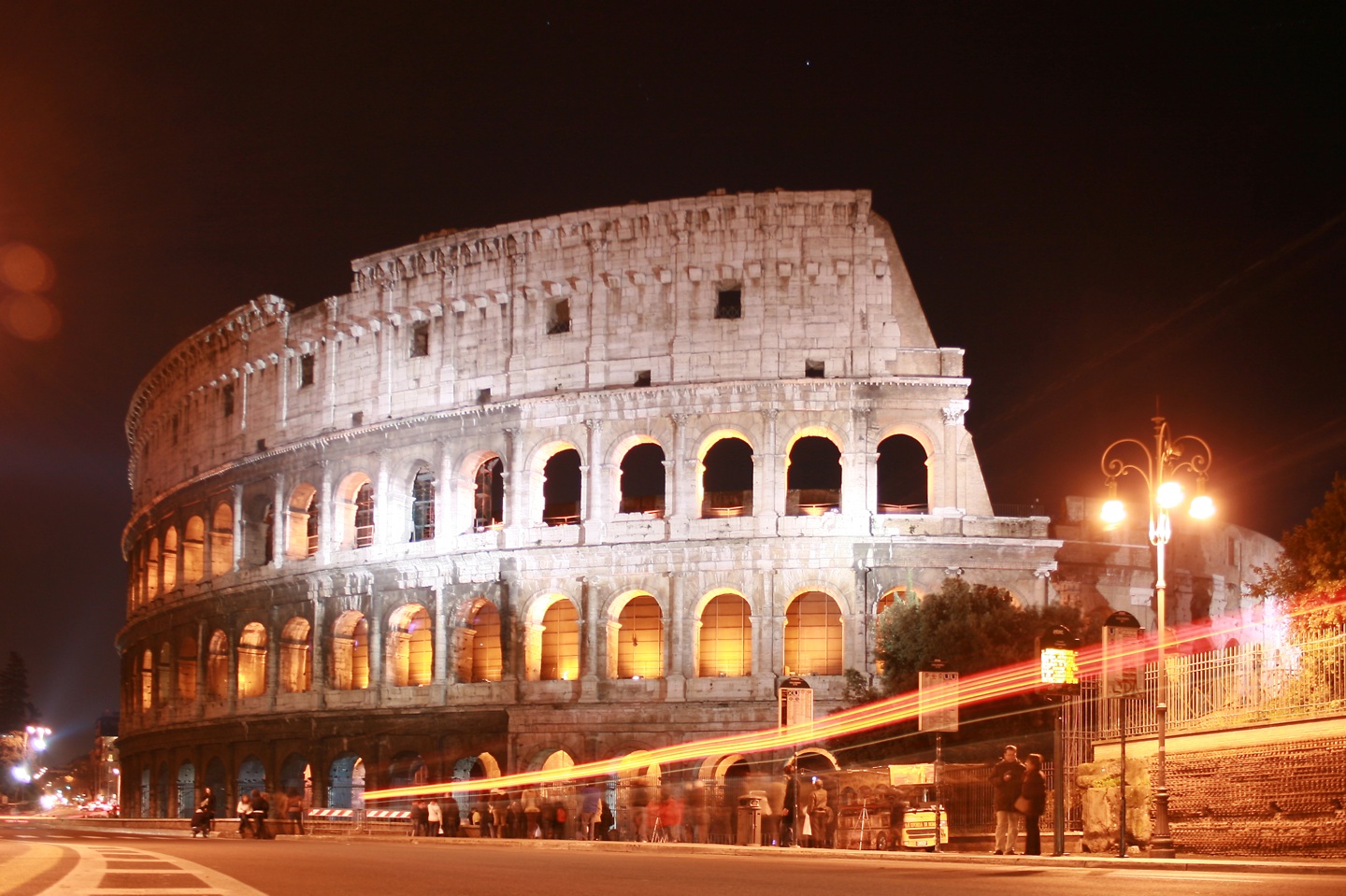
Until I've visited every great city in the world I won't know for sure if Rome is my favorite, but were I to be hit by a camel tomorrow while touring Khartoum, I suspect a sigh over never seeing Rome again would emerge as my life passes before me.
Italians like nothing more than to dismiss the gastronomy of Rome as too excessive, too rich, and too expensive. Of course, Italians in every city say similar things about every other city too, but when it comes to Rome, I think the rest of Italy is just plain jealous.
Rome has a much deeper, broader gastronomy than any other Italian city. Indeed, the old adage that all roads lead to Rome might describe the infusion of meats, seafood, and vegetables that pour into the city night and day. Rome has a wide-ranging indigenous cuisine that includes beloved dishes like abbacchio (baby lamb with mint) coda alla vaccinara (braised oxtail), carciofi alla giudea (fried baby artichokes) trippa alla romana (stewed tripe), spaghetti alla carbonara (with eggs and bacon) and cacio e pepe (pasta with pecorino cheese and black pepper), while happily welcoming other regional specialties to its belly, so that you can get first-rate Sicilian, Tuscan, and Abruzzese cooking in the city’s restaurants.
I will admit that the wines of Rome’s region of Latium are only beginning to distinguish themselves, despite 26 D.O.C. appellations—few of which you will ever run across in the city’s enotecas. That failing aside, Rome has the best of everything--hotels, food, wine, not to mention history and art.
And now, with the euro weakening, a good splurge may be the best thing to consider before the world crashes. And remember: In Italy service and tax are usually included in the price of the food, although some trattorias now leave the service out. Look for the words "servizio incluso" on the bill or ask if it is not.
Via Ludovisi 49
06-478 121
www.hoteleden.com
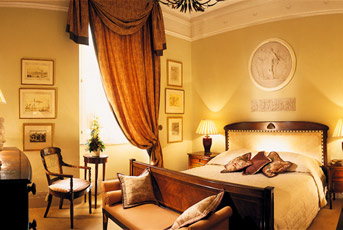 A
pleasantly narrow street off the broad Via Veneto, nearly a cul-de-sac,
leads
to this quietly secluded hotel, whose mix of fin-de-siecle architecture
and fine modern amenities makes it ideal for both business and for
getting
away from the rush of Rome's seemingly mindless traffic. The modestly
sized lobby offers a
purer sense of Roman hospitality, for the greeting is genteel and warm,
and everything clicks into place immediately.
A
pleasantly narrow street off the broad Via Veneto, nearly a cul-de-sac,
leads
to this quietly secluded hotel, whose mix of fin-de-siecle architecture
and fine modern amenities makes it ideal for both business and for
getting
away from the rush of Rome's seemingly mindless traffic. The modestly
sized lobby offers a
purer sense of Roman hospitality, for the greeting is genteel and warm,
and everything clicks into place immediately. When my wife and I arrived, quite late, thinking we might have missed our reservation for a dinner table upstairs, we were calmed by the manager, told that whenever we were ready to dine, no problem. Since we'd arrived after the closing of the local rental car office, the doorman told us they would happily return the car the next day, and also arranged for us to take a house car out to the airport at a price (about 45 euros) at or below what a taxi would cost.
So we eased our way to a very beautiful room with its own leafy terrace, which we put to good use the following morning at breakfast, just as the city was waking up to the sounds of thousands of water and wine bottles being carted away.
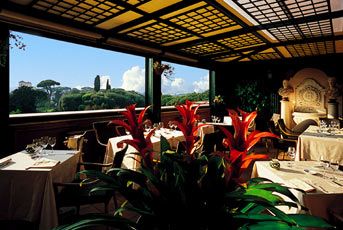
You might well book a table at La Terrazza dell’Eden simply for its stunning panoramic view of Rome from the sixth floor of the Hotel Eden (right). But in fact this is one of the finest restaurants in Rome and understandably booked just about every lunch and dinner. The room itself is subdued in color and décor, but the excitement is on the plate, with Brescia-born chef Adriano Cavagnigni showing a delicate balance of the old and the new in the same dish. Thus, you might begin with zucchini blossoms stuffed with ricotta and taleggio cheese, black olives and cherry tomatoes, or a creamy artichoke risotto with the finest pecorino di Fossa cheese, then for a main course indulge in a swordfish steak with sweet-and-sour spinach, tomato fondue, and roasted root vegetables, or spiced breast of guinea fowl in an herb crust with onion fondue and a light mustard sauce. I’d also argue that his pineapple raviolo with a lime-and-rum sorbet is the best dessert in Rome right now.
Incidentally, this is one of the few prestige hotel restaurants that is frequeted as much by Romans as by visitors.
La Terrazza is open daily for breakfast, lunch, and dinner. Main courses 26€-59€ ; fixed-price menu 100€.
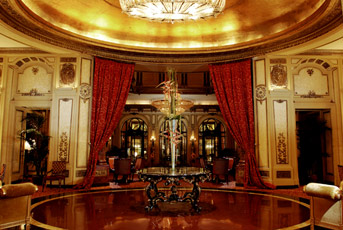 St.
Regis Grand Hotel
St.
Regis Grand Hotel
Vittorio E. Orlando 3
06-47091
www.stregis.com
Starwood
Hotels has poured $35 million into renovating this dowager of a hotel,
and they've done so without ruining the true original majesty of the
place. Niknety percent of romance os good lighting, said
Noël Coward, and throwing soft lights on the gilded lineaments of
the
Grand's architecture, including the once gloomy reception area, has
done
wonders for this famous and historic hotel, which was opened in 1894 by
the illustrious César Ritz, who brought in the equally
illustrious chef
Auguste Escoffier to whip the kitchens into shape.
Today it is still an awesome sight to
push through the revolving doors and see the spectacular lobby
here,
proceeding into the space beyond, surrounded by potted ferns and hung
with a glorious chandelier reflecting the gold cupola above it. The
improvements have been subtle on
this, the ground floor, but the rooms have all been refurbished to a
high degree of polish. Some rooms' bathrooms remain small, however.
The hotel has recently introduced
"E-Butler service," with your personal butler carrying a wireless
handheld device so you can e-mail your wishes straight to him from any
location in the city, which means you can finish up your sightseeing
around the Pantheon or Sistine Chapel and have your bath drawn by the
time you get back
to the hotel.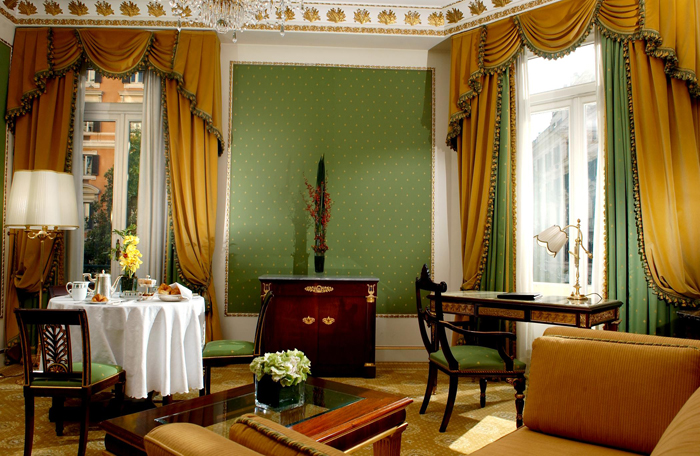
The restaurant here is called Vivendo
(below), a very smart double
room with impeccable service and a fine cadence to the evening.
When I dined here a year ago I thought Chef Francesco Donatelli was
trying a bit too hard to be innovative, but a meal just last month
indicates that he has refined his creativity within traditional forms
of Roman and Italian cuisine, resulting in elegant, very delicious
food.
I began with marinated tuna filet
in a Sicilian orange reduction with a Roman puntarelle green salad--the
play of sea, salt, sweet, and vegetal in exquisite harmony.
Sautéed goose loie gras came graced with the sweet Moscato di
Pantelleria wine and
some raisin bread with pineapple chutney, finished off with a little
scoop
of foie gras ice cream that balanced the sweet flavors by chilling the
palate slightly. One clear example of Donatelli's marrying of the
old and new was a dish of prawns gratinata
on warm eggplant parmigiana
given a dressing of
celery and bottarga
dried roe.
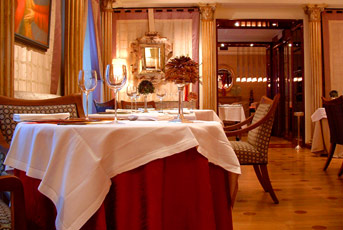 Our
pastas were both superb: Light cannelloni
filled with rich ossobuco
meat on saffron potatoes with a lemon-rosemary gremolata, and a simply
wonderful--and wonderfully simple--tagliolini
with fresh porcini and melted
Parmesan fonduta.
My companion, who is vegetarian, ordered a main course of zucchini
tartlet with the vegetable's orange-green blossoms on a leek and potato
cream--a
lustrous dish for anyone's palate; I carnivorously tore into thick
slices of fine beef in a reduction of red wine and honey, served with
capers, and a rosemary-scented potato fritter.
Our
pastas were both superb: Light cannelloni
filled with rich ossobuco
meat on saffron potatoes with a lemon-rosemary gremolata, and a simply
wonderful--and wonderfully simple--tagliolini
with fresh porcini and melted
Parmesan fonduta.
My companion, who is vegetarian, ordered a main course of zucchini
tartlet with the vegetable's orange-green blossoms on a leek and potato
cream--a
lustrous dish for anyone's palate; I carnivorously tore into thick
slices of fine beef in a reduction of red wine and honey, served with
capers, and a rosemary-scented potato fritter.
The ubiquitous soft-centered chocolate tartlet
has found its way to Vivendo in fine form, but I would urge, after a
splendidly lavish meal like this, the gelati and sorbetti.
Vivendo's winelist is very good, with
both Italian and international selections.
Vivendo
is open for lunch Mon.-Fri., and for dinner Mon.-Sat. Antipasti run
18€-28€, pastas 18€-24€, main courses 22€-34€. There is also a 8-course
"Experience" tasting menu at 90€, with five wines 135€. Service and tax
included.
The
Westin Excelsior
Via Veneto 125
06 47081
www.excelsiorrome.com
 The
most visible and familiar
hotel on the Via Veneto, the Excelsior has played host to countless
movie
stars since the 1950s when Rome was a cinema capital. Actress
Anna Magnani and playwright Tennessee Williams (left) stayed here at the time
she starred in "The Rose Tattoo."
The
most visible and familiar
hotel on the Via Veneto, the Excelsior has played host to countless
movie
stars since the 1950s when Rome was a cinema capital. Actress
Anna Magnani and playwright Tennessee Williams (left) stayed here at the time
she starred in "The Rose Tattoo."
After a $7 million rehab, the Excelsior
has retained all the glamor with none of the archaic notions of
Roman excess. The 287 guest rooms and 32
suites have all been brought up to contemporary standards, from
flat screen TVs to large marble bathrooms. It also has a very beautiful
swimming pool and up-to-date fitness center.
A tedious flight from Palermo and a taxi ride
through Rome at rush hour roughed us up a bit, so plopping down on the
king-size bed in a silken room of brocade and fine carpeting was the
best balm we could imagine in order to relax into a good nap before
dinner.
Do not miss visiting the ORVM
bar here (right)--a
splendidly sophisticated place, all light and color, but do
bring plenty of euros. A round of cocktails cost me 28€ one
evening! You may also eat lightly here: the place is open from 10 AM
onward.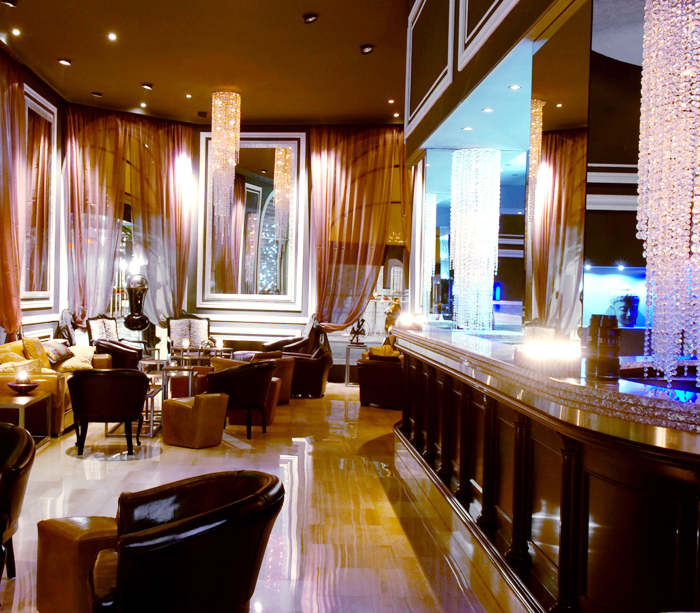
The dramatically designed restaurant of the
Excelsior is Doney, which is
well
known for its grand buffet at lunch, and the
black-and-gold dining room, with shimmering curtains opening onto the
Via Veneto is a very romantic and festive venue, where chef James
Foglieni (below) takes in the
whole Mediterranean for his men, which might
include Catalan lobster, Alaskan crab, and foie gras with
Sauternes. Some of his specialties dishes from "Mare Nostrum"
(our sea, which is the Mediterranean) which includes a tomato and
oregano “risotto” with raw scampi and buffalo burrata; a ceviche of
true scampi and red king prawns marinated with dry vermouth, and
Breton lobster in tempura.
 He also
does a torta of baked ricotta cheese with cinnamon, Indian figs,
and bresaola,
and a rich but light soufflé
alla Parmigiano, well filled with white truffles and porcini. His pastas
consist of lovely ideas like risotto with codfish baccalà, aromatic saffron,
and
bone marrow gratin; spaghetti
with sea urchins and Swiss chard; and tagliolini
with Sicilian
pistachios, scampi, lemon and rocket salad.
He also
does a torta of baked ricotta cheese with cinnamon, Indian figs,
and bresaola,
and a rich but light soufflé
alla Parmigiano, well filled with white truffles and porcini. His pastas
consist of lovely ideas like risotto with codfish baccalà, aromatic saffron,
and
bone marrow gratin; spaghetti
with sea urchins and Swiss chard; and tagliolini
with Sicilian
pistachios, scampi, lemon and rocket salad. To be sure, the seafood at Doney
is some of the most enticing
in the city: sliced corvina fish with lime, blue lobster salad, and
Pienza
pecorino cheese; grilled sturgeon with asparagus salad and
crayfish; and roasted monkfish with vanilla, potatoes and almond
biscuits--unusual dishes that push the edge of la cucina di pesce moderna in Rome.
Meat dishes tend to be hearty, like his
braised veal cheek with Cesanese wine sauce, polenta and Lombardian bagòs
cheese; and his loin of rabbit with fine herbs, and a Spanish
“Empanada” stuffed with hazelnuts and “Chorizo” salami.
Doney is open daily for
breakfast, lunch, and dinner; Antipasti run €19-€60, pastas €16-€26,
main courses €24-€32, with a 5-course tasting at €55.
Il
Palazetto
International Academy of Wine
Vicolo del Bottino 8
06-699-0878
www.wineacademyroma.com
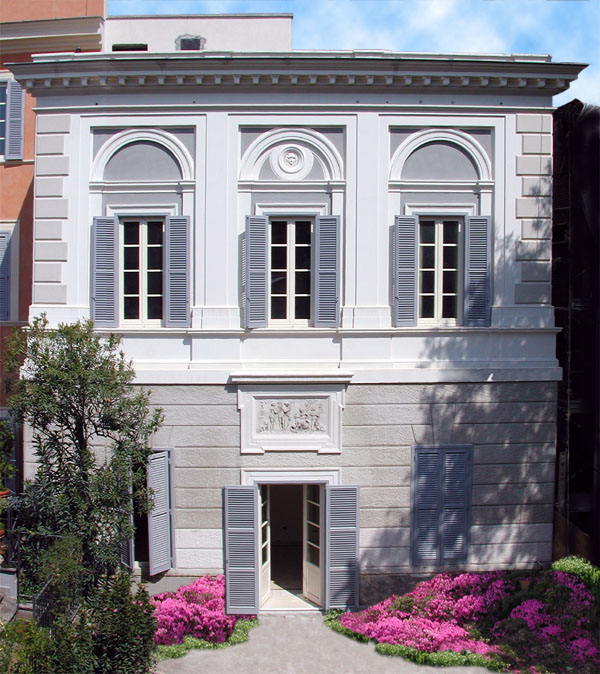 My friend Ian d'Agata
runs the International
Wine Academy here on the Spanish Steps, which also houses Il
Palazzetto, a small, very charming, very elegant boutique hotel that is
part of the
larger Hassler Hotel at the top of the
steps. Built in the 1500s, Il
Palazzetto retains the aristocratic taste of its former owners, a noble
family of Rome, and its situation could hardly be better.
My friend Ian d'Agata
runs the International
Wine Academy here on the Spanish Steps, which also houses Il
Palazzetto, a small, very charming, very elegant boutique hotel that is
part of the
larger Hassler Hotel at the top of the
steps. Built in the 1500s, Il
Palazzetto retains the aristocratic taste of its former owners, a noble
family of Rome, and its situation could hardly be better.
The
rooms are exquisite, and, depending on your affection for such things,
the fact that the windows open onto the comings and goings of the
throngs that come to the Spanish Steps gives you a unique look at
life in Rome, even if, as for centuries, it is occupied by foreigners.
The Academy opened in 2002 and Ian is
its indefatigable host, director, connoisseur, gourmet, and teacher,
holding wine tasting courses, wine tours, (in Italian, English, and
French),
select wine tastings featuring the best producers from Italy and around
the world, as well as “Meet the wine-maker” and “Great Chefs” dinners,
in which a winemakersor chef is invited to the evening and presents his
or her wines or culinary creations. (Ian also has a terrific new book
on
Italian wines coming out that I shall be writing about later this year.)
Il
Palazzetto Restaurant is a refined, small
venue here that's both part of the program and open to the public for
dining. It
is particularly 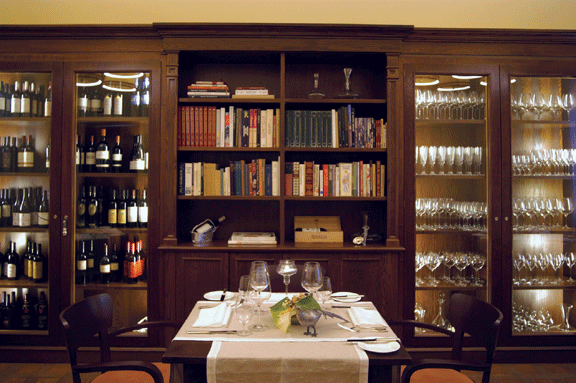 enchanting
when the outdoor garden terrace is open in good weather. Inside is a
lovely Library room (right),
where I recently sat down with Ian for a true Roman lunch, which began
with a beef carpaccio simply
dressed with olive oil and Parmigiano. My
first meal in Rome that day, I immediately went for the spaghetti alla
carbonara, which came with golden noodles that must have used up
an
entire henhouse of eggs in the pasta, mixed with the traditional guanciale bacon, eggs
that are cooked by the heat of the pasta, and pecorino cheese--a great
restorative, making me able to walk up and
down the Spanish Steps to have an espresso at the historic Caffé
Greco, here since 1760,
on the Via Condotti. (Psst!
Have your coffee at the counter; sitting down at a table will cost you
a lot more.)
enchanting
when the outdoor garden terrace is open in good weather. Inside is a
lovely Library room (right),
where I recently sat down with Ian for a true Roman lunch, which began
with a beef carpaccio simply
dressed with olive oil and Parmigiano. My
first meal in Rome that day, I immediately went for the spaghetti alla
carbonara, which came with golden noodles that must have used up
an
entire henhouse of eggs in the pasta, mixed with the traditional guanciale bacon, eggs
that are cooked by the heat of the pasta, and pecorino cheese--a great
restorative, making me able to walk up and
down the Spanish Steps to have an espresso at the historic Caffé
Greco, here since 1760,
on the Via Condotti. (Psst!
Have your coffee at the counter; sitting down at a table will cost you
a lot more.)
I also enjoyed sliced steak, good and rare,
with mashed potatoes and wild mushrooms, and a breaded veal cutlet with
spinach and a squirt of lemon juice. Desserts were a delight, including
one of the best tiramisùs I've
ever had--lighter and every bit as good was a carpaccio of
pineapple with chocolate ice cream.
Il Palazetto
restaurant is open for lunch and dinner Tues.-Sun. Antipasti run
€7-€12, pastas €12-€16, and main courses €18-€25.
Al
Ceppo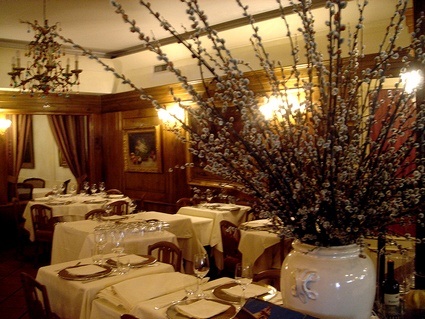
Via Panama 2
+39 6 841 9696
www.ristorantealceppo.it
Ian
D'Agata took my
wife and me here for Saturday dinner, perhaps with some reluctance,
because he doesn't want the
place to be known to too many people. But, since the pleasingly
elegant, wholly unstuffy Al Ceppo has been here in the Parioli district
for nearly four decades, run by generations of women from the Marches,
and since the restaurant is easily found with high praise in every
worthwhile guidebook
to Rome, there isn't much chance of my telling you about it causing a
meltdown
of new clientele.
Despite its duration in business,
Al Ceppo is fresh looking, beautifully lighted with fine napery and
stemware, polished wood, thick draperies, an open rotisserie-grill up
front, very fine portraits of
women throughout, and a bonhomie of welcome that is not always the case
in Roman restaurants.
We began conservatively enough with some
flavorful culatello di zibello
ham with figs, and little croquettes of trippa (tripe) alla romana with tomato, pecorino
and mint--both true appetizers in that we were ravenous for more
easy-to-love food. An insalata of
fresh porcini with celery
and
Parmigiano helped clear the palate for a ravioli of potato with a wild
mushroom sauce; a tagliatelle
with wild mushrooms and toasted breadcrumbs scented with Roman's
favorite herb, mint; and tagliolini
made from a type of wheat flour called kamut
with baby calamari and cuttlefish with fresh tomato sauce.
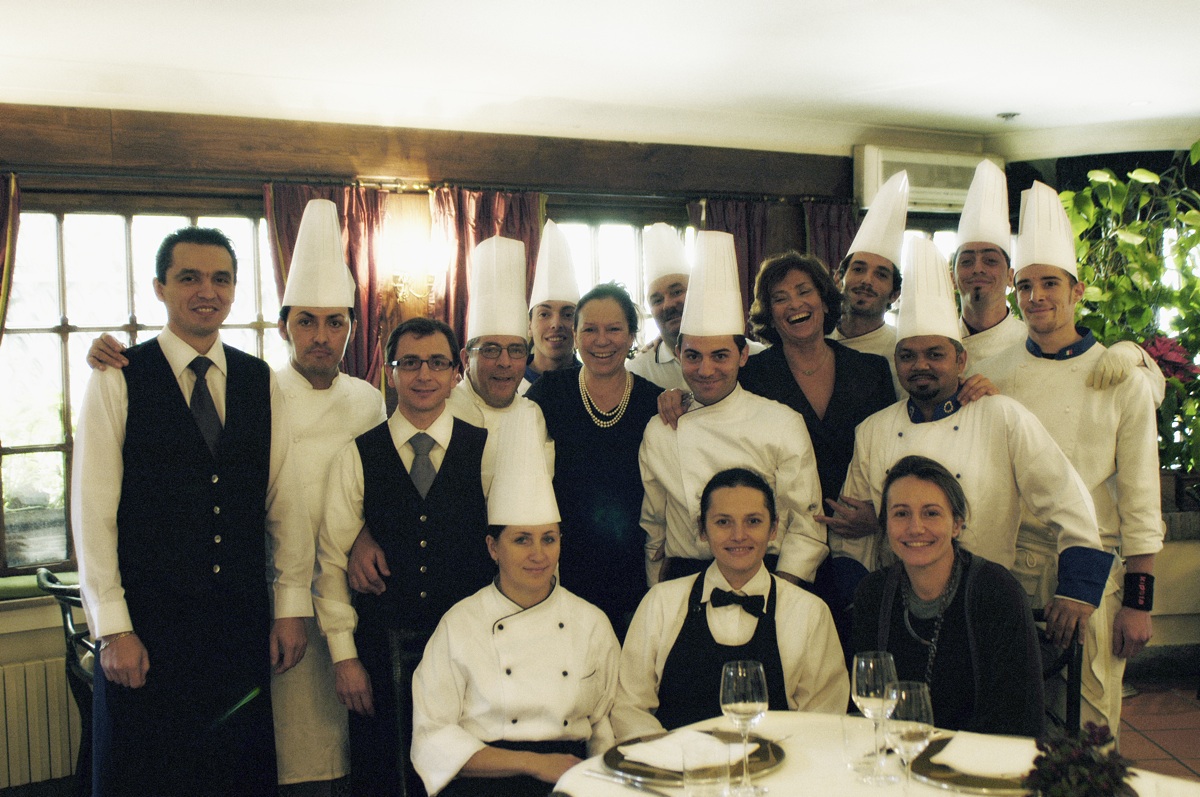 We
were feeling in fine fettle with such food under our belt, but there
was nothing to stop us from forging ahead with veal sweetbreads with
buffalo mozzarella and an intriguing millefeuille of spinach with
coffee sauce. Tender and full-flavored was a pork fillet with pepper
and honey and Belgium endive braised with a little orange--a very
lovely idea. Crisply cooked veal with herbs was the last of the meats
and the simplest.
We
were feeling in fine fettle with such food under our belt, but there
was nothing to stop us from forging ahead with veal sweetbreads with
buffalo mozzarella and an intriguing millefeuille of spinach with
coffee sauce. Tender and full-flavored was a pork fillet with pepper
and honey and Belgium endive braised with a little orange--a very
lovely idea. Crisply cooked veal with herbs was the last of the meats
and the simplest.
Some superb Italian cheeses
followed with which to finish our wine--Al Ceppo has an amazingly fine
list--and we still had a little room for wonderful desserts like a warm
tartlet of pears with pineapple sauce and yogurt gelato, and a tart of
bitter chocolate with chestnut snaps and coffee sauce.
This is sophisticated and very refined
city food, the kind that distinguishes a great ristorante from a very
good trattoria. It is also
the kind of restaurant the Michelin Guide
would never award a star to because it is not fussy or French enough
for their Gallic tastes. Rome doesn't have nearly as many
restaurants of this caliber as it should, and for a lesson in
hospitality it has even fewer. These women of Al Ceppo know how
to take good
care of their guests.
Al Ceppo is open
Tues.-Sun. Antipasti run €15-€20, pastas €16-€18, and main courses
€21-€30.
~~~~~~~~~~~~~~~~~~~~~~~~~~~~~~~~~~~~~~~~~~~~~~~~
. . . AND FOR A GOOD PIZZA
by
Mort
Hochstein
On
a recent trip to Rome, my quest for
the best pizza in Italy resumed in an unfamiliar neighborhood.
Our exploration took us to Città
del Gusto
(City of
Taste), a culinary academy in the Marconi district on the south
side of the city, far from the usual tourist trails, with dense blocks
of apartments and bustling business avenues that reminded me of
Queens in NYC. The hostaria
we targeted is in the school operated by Gambero Rosso, a
food and wine publishing house and shares space in a converted
warehouse with a huge cineplex.
There was little to prepare us for the
pleasures that lay behind the undecorative entrance. Any
hesitancy about the spare, functional entry area vanished when we
took an escalator to the second level to enter a chic, minimalist
restaurant with uncluttered tables, and few decorations other than
shelves of books and tools of the trade for
students and amateur chefs. The focus, embellished by the
familiar smells of a working pizza parlor, was on an attractive
kitchen where the chef and his team
worked. The sheer variety of pizza was overwhelming, so we
delegated choice to the chef. He started us off with a
fluffy, soft crusted focaccio's,
loaded lardo,
pig fat
cured with rosemary and other spices, a peasant staple now becoming
popular in NYC restaurants.
The highest price was 10 Euros, for a ten-inch
pie, about what we’d been paying for a slightly larger version at
John’s or Lombardi’s in NYC. Surprisingly, the style was
Neapolitan, not the thin-crusted, scorched bottom Roman variety
we’d been hoping for, but hardly deep-dish Chicago style.
The pizza, puffy alla
napolitana, soft with a
somewhat sourdough-like yeast aroma, exuded a lovely smoky
flavor.
On entering, we had seen no other patrons and
that raised early doubts. But we, the sole American tourists in the
room, were eating on our normal schedule. The Romans
arrived about an hour later and soon the place was packed with
families, young people on dates and groups of happy
eaters. We were in pizza Shangri-la and our only complaint was
that our gluttonous gorging left little room for desserts.
We dug in, however, with one final effort. My wife Rollie and I shared
a plate
of fresh fruit and my grandson Matt, never sated, put away a
globe-sized
chocolate-covered, ice cream ball, anointing it and the four-cheese
pizza as two of the best dishes he’d tried in Rome.
Afterward we went up two flights to a totally new
world, the Teatro del Vino
(above), an elegant and
sophisticated
winebar, all polished wood and gleaming modern furniture, a total
departure from the area we had just left. The sleek winebar
overflowed with the best wines in the land, no surprise
considering that the Gambero Rosso people are the ranking
wine mavens of Italy, awarding Tre Bicchieri (three
glasses) to the country’s best wines annually in a book
that becomes a bible for aficionados throughout the wine-loving
world.
The winebar, which has an Eiffel
Tower-like view of the city from its terrace, offers a
grand
selection of artisanal cheeses and salami sourced from
outstanding producers, including prosciutto carved off the
bone in its dining area. We taste-tested a platter of cheeses, all new
to us--Blue del Moncenisio, Pecora
della val Pusteria
and Robiola from
Piedmont, all nicely mated
with Castello Banfi’s Summus, a velvety marriage of
Sangiovese, Cabernet Sauvignon, and Syrah. The elegantly
professional winebar, as sophisticated a room as
any to be found in Rome, and the pizza marathon in much
simpler surroundings, are definitely
worth an excursion from the inner city.
Città
del gusto and Teatro del Vino, Via Enrico Fermi, 161; 06 55 112 21;
www.cittadelgusto.it.
Open Tues.-Sat.
TAXI!
 Having
arrived at Rome's Fiumicino Airport dozens of times, it was only on my
last trip I learned something important about the taxis there. There
are three
options (aside from the very efficient train into the city center and
the fairly efficient bus lines):
There are at least two different taxi companies at Fiumicino,
both licensed. And they both have more or less the same decal on their
front doors. But the taxi with the decal carrying the Roman acronym "SPQR" is the one you want to take,
because the fare is set at 45 euros. If you hop into a taxi with
a decal that does not display "SPQR" you will be
charged by the meter, which can run up to 55 or 60 euros. There are
of course huckster drivers who will try
to solicit your business, but as long as you settle on the same price
as an authorized taxi will charge you--45 euros--you're O.K.--John Mariani
Having
arrived at Rome's Fiumicino Airport dozens of times, it was only on my
last trip I learned something important about the taxis there. There
are three
options (aside from the very efficient train into the city center and
the fairly efficient bus lines):
There are at least two different taxi companies at Fiumicino,
both licensed. And they both have more or less the same decal on their
front doors. But the taxi with the decal carrying the Roman acronym "SPQR" is the one you want to take,
because the fare is set at 45 euros. If you hop into a taxi with
a decal that does not display "SPQR" you will be
charged by the meter, which can run up to 55 or 60 euros. There are
of course huckster drivers who will try
to solicit your business, but as long as you settle on the same price
as an authorized taxi will charge you--45 euros--you're O.K.--John Mariani
NEW
YORK CORNER
by John Mariani
AUREOLE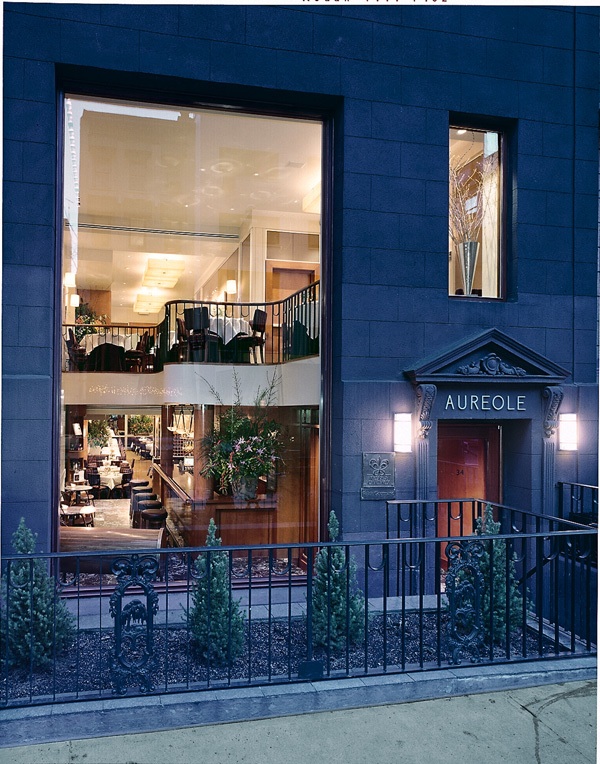
34 East 61st Street (near Madison Avenue)
212-319-1660
www.aureoleny.com
Could it possibly be twenty years ago that
Charlie Palmer opened Aureole in an east side townhouse between Park
ands Madison Avenues? Back then the anticipation was high for
its debut, which took a while, for Palmer had already built a
significant reputation as one of New York's brightest young chefs,
having made his name as chef at The River Café in
Brooklyn. Aureole was very much a restaurant of its
time--fine dining was at its zenith and there was no such thing
as "little plates" à la Stuzzichini or "molecular cuisine"
à la WD-50 or three-star
restaurants with a counter and 14 backless stools à
la Ko. Fine dining meant just that, and Aureole was
decked out to look the epitome of upper east side chic.
I will not say anything more about the
décor
at Aureole because the restaurant is going to be moving in 2009 to the
Bank of America Tower at One Bryant Park, adjacent to the NY Public
Library. Now, that, in
a time of recessionary terror, should be interesting. Not that Palmer
hasn't been a gambler: he's opened up several other restaurants in
several other cities, including a Las Vegas Aureole and where he has
plans for a namesake hotel; just about all of
them have been successes.
I would also be the first to point out
that Palmer has become one of those chef-entrepreneurs who risks
spreading himself too thin, although he has not, as yet, sacrificed his
culinary commitment to the overwhelming demands of a TV series, which
has truly overtaken the lives and careers of several of his colleagues.
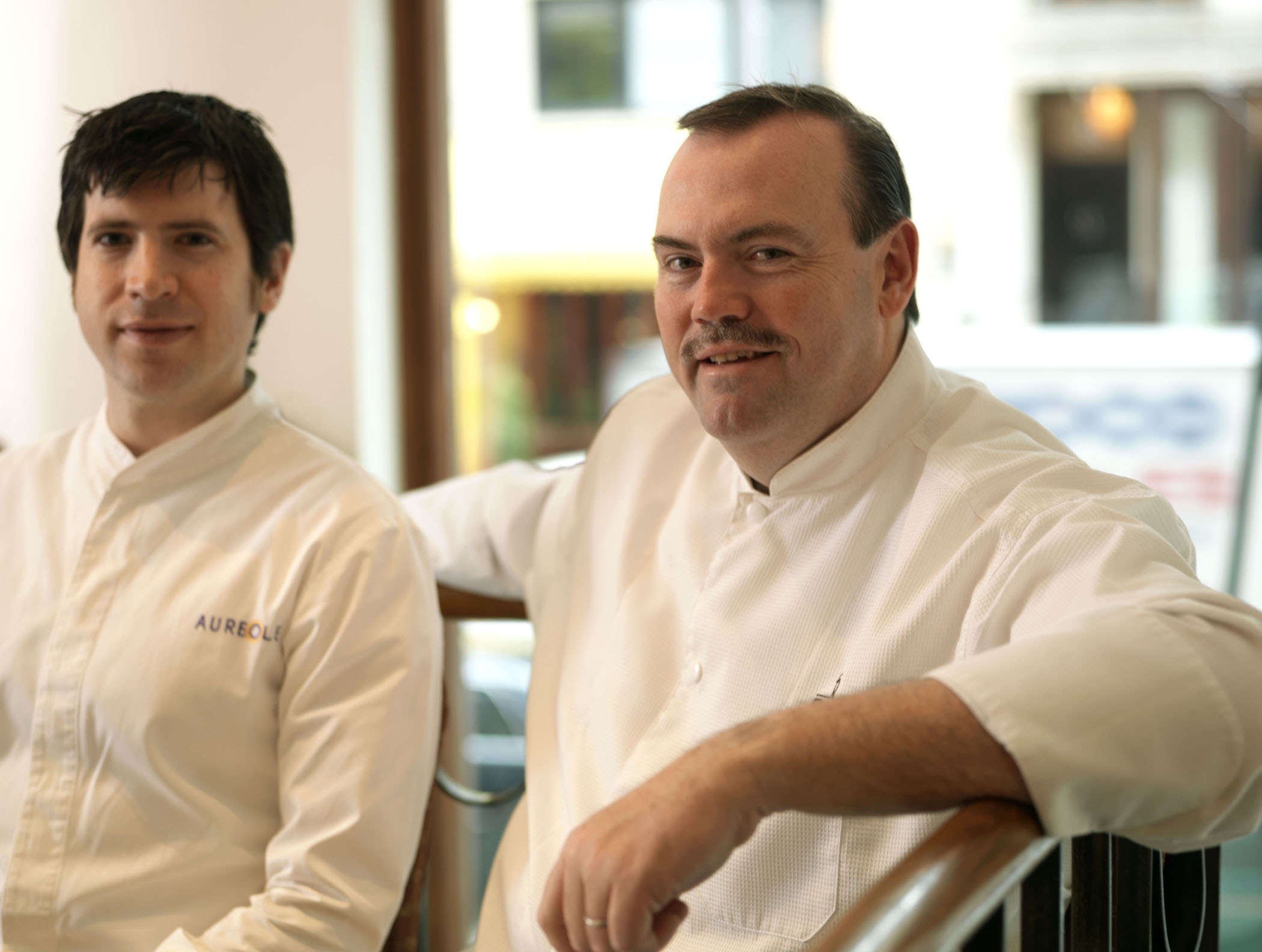 Several chefs de cuisine
(currently Tony Aiazzi, below,
with Palmer) have
passed through Aureole as a result, and yet there has always been a
consistency of style in the kitchen, so that many of the dishes made
popular there years ago are either still served on occasion or echoed
in newer, more contemporary versions. The scallop
sandwich of sea scallops in a crisp potato crust with saffron pan
juices, which was on the very first menu, is still one of the most
popular dishes today. Which is why on a visit
this month I felt so thoroughly encouraged by what I saw and ate.
If Aureole has not radically altered its cuisine, neither has it stood
still.
Several chefs de cuisine
(currently Tony Aiazzi, below,
with Palmer) have
passed through Aureole as a result, and yet there has always been a
consistency of style in the kitchen, so that many of the dishes made
popular there years ago are either still served on occasion or echoed
in newer, more contemporary versions. The scallop
sandwich of sea scallops in a crisp potato crust with saffron pan
juices, which was on the very first menu, is still one of the most
popular dishes today. Which is why on a visit
this month I felt so thoroughly encouraged by what I saw and ate.
If Aureole has not radically altered its cuisine, neither has it stood
still.
We
began with sautéed sweetbreads with black trumpet mushrooms,
green raisins, and a smoked almond froth, a dish typical of the balance
of Aureole's past and present, and a very good starter for autumn.
There is a fine selection of charcuterie, and a tuna tartare
"arabesque" was rich, fat tuna with a charred eggplant puree,
barberries, preserved lemon, and spicy mint oil, which you'd be hard
put to find in even the best restaurants in the Middle East. A
salad of bitter greens with poached apricots and Dijon vinaigrette
promised some duck confit, but it was not easy to find in there.
From a tasting menu came thyme-roasted filet mignon
of excellent quality, with wild mushrooms and wilted watercress, and
black-pepper horseradish gnocchi
that were toothsome but too soft. Caramelized sea scallops with fresh
linguine, citrus and crab and a lemongrass emulsion was a nice light
seafood offering, while butter-roasted lobster with sweet corn and
chanterelle pudding and baby onions was the essence of autumn, though a
very rich dish indeed. In the same autumnal mode was pan-roasted
monkfish with lobster and an squash risotto with a vanilla infusion
that worked beautifully. Pork tenderloin of good quality came crusted
with country ham, though it was almost indiscernible, accompanied by
shrimp and white corn grits and a classic sage and shallot jus.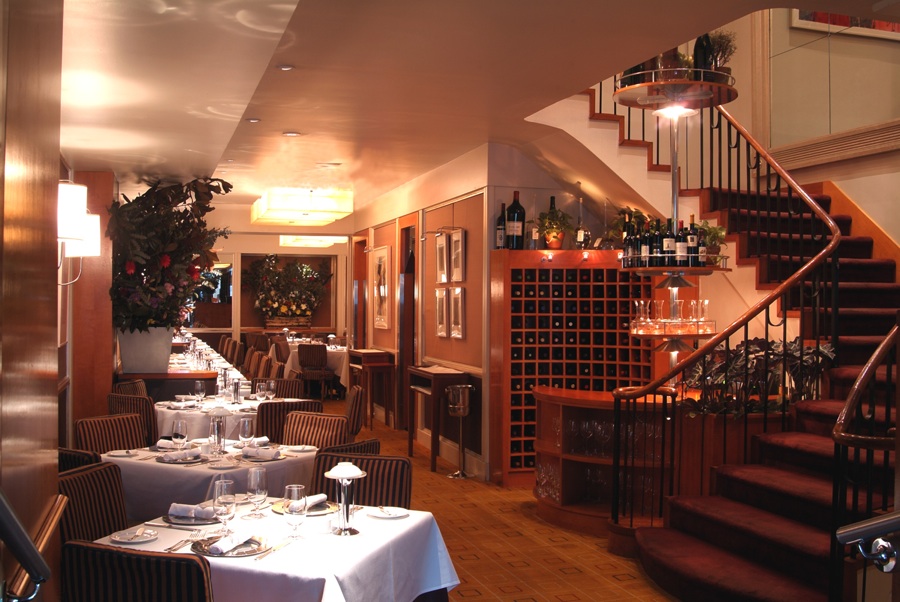
Desserts at Aureole, by Rachel Lansang-Hidalgo, hit that ideal
spot where creativity and sheer good taste cooperate rather than clash,
so that a blackberry and pluot (a cross between a plum and apricot)
cobbler was almost perfect
on its own, but the addition of fromage
blanc sorbet and black pepper crème anglaise made it so. Also
ideal for the season was a crème brûlée trio
flavored with vanilla, lemon thyme, and toasted sesame seeds, and I was
delighted with a caramelized Mission fig upside down cake with banana
ice cream and nougatine. Misconceived, however, was a milk chocolate
mousse and peanut crunch with grape jelly sorbet and salted caramel
peanuts; the addition of salt to desserts, particularly caramel, is a
smart contemporary addition but it's getting too salty in a lot of
kitchens recently.
Aureole's winelist, overseen by
sommelier Justin Lorenz, is 700 selections strong.
Two decades in the restaurant
business is a very long time, but now, with its removal to new
quarters,
Aureole may be said to be that over-used word, a survivor. More
important, it has reached classic status, a very New York place, with
a cuisine and service style that brings the word cosmopolitan into
stylish focus.
Aureole is open for
dinner Mon.-Sat. The fixed price menu is $84; a 7-course tasting menu
is $115, with wines $195.
NOTES
FROM THE SPIRITS LOCKER
 Añejo
Tequilas Make Better Margaritas
Añejo
Tequilas Make Better Margaritas
by John Mariani
I have long been a believer that the better the booze the
better it
should be left out of a cocktail, because the other ingredients cancel
out the subtleties of flavor in expensive spirits like $60 vodkas, $100
Singe Malts, and $400 Cognacs.
Which is why, when ordering a
margarita, I have always been content with using low-priced blanco
(white) tequilas rather than the premium añejos (aged). I was
recently
buoyed in this belief when Silvana Salcido Esparza, chef-owner of the Barrio
Café in Phoenix,
insisted, “The agave fruit’s true
essence is best expressed in a blanco tequila, and the orange liqueur,
lime juice, and salt in a margarita will compromise the flavor of
añejos.” She should know: Barrio Café carries 250 different
tequilas, and her point seemed perfectly convincing as I sipped her
superlative blanco-based margarita with her freshly made guacamole with
pomegranate seeds.
But last week I enjoyed a margarita made with
an añejo tequila, Cabo Uno,
and I was struck by how much better the
cocktail was than with any blanco I’d ever had. The drink became
far more complex in flavors, with that identifiable smokiness of an
añejo and the richness of a distillation made from 100 percent
blue
agave (above and right).
(Mexican regulations allow a spirit to be called tequila if it
contains a minimum of 51 percent agave-derived sugar, which is usually
what blancos are.)
Cabo Uno ($250) is the top-of-the-line anejo
made by Cabo Wabo, which has been owned since 1996 by rock-and-roll
singer Sammy Hagar. The company makes a full line of tequilas, but the
Cabo Uno is made from 100 percent blue weber agave and matured in white
oak barrels for 38 months, with each bottle signed and numbered. It is,
to be sure, made for sipping, not knocking back with a lick of salt on
your forearm. But I found it made one helluva great margarita, with the
fresh juice of one lime, an ounce of Cointreau, and a light rim of sea
salt.
This Mexican epiphany forced me, for
journalistic purposes, to try a range of premium anejos now on the
market at a time when certain tequila brands, like Chinaco, El Tesoro,
and Patron have gained cult status. Longtime producers like José
Cuervo, Don Julio, Sauza and others have, therefore, been coming out
with a range of small-batch, very expensive tequilas for a
connoisseur’s market. They also put them in very beautifully designed
bottles.
 I certainly agree that these are
tequilas to be savored, just as you might a fine Cognac or Single Malt
Scotch. But because they are considerably lighter in body than
those two spirits, with distinctive, delicate notes of light oak,
caramel, and nuttiness, many premium añejos are absolutely
wonderful in
margaritas.
I certainly agree that these are
tequilas to be savored, just as you might a fine Cognac or Single Malt
Scotch. But because they are considerably lighter in body than
those two spirits, with distinctive, delicate notes of light oak,
caramel, and nuttiness, many premium añejos are absolutely
wonderful in
margaritas.
Don
Julio Real (once only
available in Mexico) is quite pale in color, with an apple aroma, very
smooth and elegant, well rounded; you might even serve it straight as
an aperitif. Still, at $350 you may want to think about Don Julio 1942
($125), which has more brawn and a long, heated finish, with good
vanilla-caramel notes. It’s a very good anejo indeed.
Some añejos I tasted bore
remarkable
resemblance to whiskies: Milagro Añejo ($95), triple distilled,
was
warm, with a rich, sweet undertone, and medium heat rather than the
sting of less refined tequilas.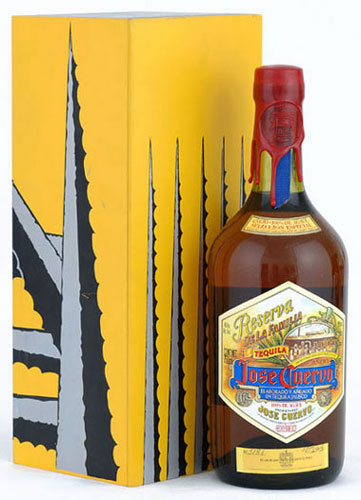
El Tesoro de
Don Felipe Añejo ($50) is aged
“two to three years,” yet it is quite pale. Both the nose and the
follow-through have distinct, very likable black pepper notes, which I
found added another dimension to a margarita.
In some ways the most impressive, though the
least typical, anejo was the José
Cuervo Reserva de la Familia ($115),
introduced in 1995 on the company’s 200th anniversary. Each year it
comes in a wooden box designed by a well-known Mexican artist.
This is a tequila I would definitely not shake into a margarita.
The amber color goes deeper than any others I sampled, and the pleasant
bite is far more like a briary Scotch whisky from Islay. It is truly a
tequila to be enjoyed after dinner, preferably while listening to Diana
Krall croon “Besame Mucho.”
One more thing, if you do specify an
añejo in
a margarita, do not order a frozen one. The pulverized ice dilutes any
of the virtues an añejo brings to the drink, and you end up with
more
slush than flavor.
John
Mariani's weekly wine column appears in Bloomberg Muse News,
from which this story was adapted. Bloomberg News covers Culture from
art, books, and theater to wine, travel, and food on a daily basis, and
some of its articles play on the Saturday Bloomberg Radio and TV.
LIEBFRAULMICH
TAKES ON A WHOLE NEW MEANING
Hans Locher, owner of Storchen restaurant in
Winterthur, Switzerland, is serving dishes containing 75 percent
human breast milk, obtained by taking out ads offering $5.40
for 14 ounces of milk. “I first experimented with breast milk
when my daughter was born,” says Locher. “One can cook really delicious
things with it. However, it always needs to be mixed with a bit
of cream, in order to keep the consistency.” . . . MEANWHILE, BACK IN THE U.S.A:
Having
heard about Herr Locher's noble experiment the People for the Ethical
Treatment of Animals (PETA) has asked the owners of Ben & Jerry's
ice cream to use human breast milk instead of cow's milk, insisting it
would "lessen the suffering of dairy cows and heir babies on factory
farms and benefit human health." Ben & Jerry's demurred, saying,
"We
believe a mother's milk is best used for her child."
 WHO
WOULDN'T?
WHO
WOULDN'T?
“I first Visited Delhi in December 1993 [and] I didn’t leave for three
weeks. Those 22 days still rank among the most soul-stirring of my
life. On my second night in town, I walked the entirety of Chandni
Chowk, Old Delhi’s half-mile-long bazaar. . . . Stray cows lapped at
the pavement. Visions burst out of the shadows. The mere act of walking
down the street was as thrilling as a skydive. It certainly wasn’t
easy: the pollution was overwhelming, the squalor so distressing that
at times I thought I’d have to take the next flight home. But it was
too late: on that night in Chandni Chowk, I had fallen in love with
India.”—Peter Jon Lindberg, “Delhi’s New Beauty,” Travel & Leisure (October 2008).
QUICK BYTES
TO ALL PUBLICISTS: Owing to the amount of material sent to this newsletter regarding Thanksgiving, Christmas, and New Year's dinners--many of which are only announcements as to price fixed dinners--it is impossible for me to include any but the most unusual of events for those holidays in Quick Bytes.
--John
Mariani
* In Sausalito, CA, from Nov. 11-15
Poggio’s Chef Peter
McNee, will feature white truffle dishes along with specially selected
Piedmont's wines, including Poggio’s own Nebbiolo and vintage Barolos
and Barbarescos. Call 415-332-7771 or go to www.poggiotrattoria.com.
* The return of regional dinners at
NYC’s Mercadito and Mercadito Grove with Chef Sandoval
is offered from now until Feb. with five special menus at $30 pep, with
the option of a $20 drink pairing. For schedule go to
www.mercaditorestaurants.com or call 212-529-6490.
* During November in Washington,
DC, Taberna del Alabardero
features its 2nd annual Simply Seafood menu (meat and vegetarian dishes
will also be available).Visit www.alabardero.com. Call
202-429-2200.
* The
Taj Hotel in Boston begins a Bollywood Nights series on Nov. 19
and takes through March 2009, complete with exotic lighting and
décor with jewel-toned draperies, silk pillows, mood-enhancing
candles, Bollywood clips on screens, dancing to entrancing
international selections by a DJ and sip Taj Palace Cocktails, Thandai
and Cardamom tea. Choose from Indian specialties created by Chef
Prabeen Prathapan. $25 pp. Call 617-598-5255.
* On Nov. 20-23 Paris Las Vegas holds its 2nd Annual Beaujolais Nouveau Celebration, with special events, tastings and Beaujolais Nouveau featured wine pairing menus at its restaurants. Visit www.parislasvegas.com; call (877) 603-4386.
* From Nov. 21-23 InterContinental Hong Kong holds
its first annual “Dramatic Wine & Dine Experience,” with Michael
Fridjhon, Pierre Lurton, of Chateau d’Yquem and Chateau
Cheval Blanc; Thibault Liger Belair of Domaine Thibault Liger-Belair;
Bernard Hervet of Domaine Faiveley and François Hautekeur of
Veuve Clicquot La Grande Dame. Their wines will be paired with cuisine
from InterContinental Hong Kong’s restaurants, along with guest
chefs from some of the world’s leading restaurants. The package
price for all four Wine & Dine events is $2,300 pp. Call 852
2721 1211; www.hongkong-ic.intercontinental.com.
*On
Nov. 21 in Paso Robles, CA, Adelaida
Cellars presents its Annual Beaujolais Nouveau Celebration to
salute the first release of the 2008 Central Coast vintage. Chef Claude
Chazalon of Safran Caterer will prepare traditional French peasant fare
to accompany Adelaida’s 2008 Gamay Noir. $25 pp or complimentary to all
wine club members. Call 800-676-1232 x19; www.adelaida.com.
Everett Potter's Travel Report:

~~~~~~~~~~~~~~~~~~~~~~~~~~~~~~~~~~~~~~~~~~~~~~~~~~~~~~~~~~~~~~~~~~~~~~~~~~
Eating Las Vegas is the new on-line site for Virtual Gourmet contributor John A. Curtas., who since 1995 has been commenting on the Las Vegas food scene and reviewing restaurants for Nevada Public Radio. He is also the restaurant critic for KLAS TV, Channel 8 in Las Vegas, and his past reviews can be accessed at KNPR.org. Click on the logo below to go directly to his site.
~~~~~~~~~~~~~~~~~~~~~~~~~~~~~~~~~~~~~~~~~~~~~~~~~~~~~~~~~~~~~~~~~~~~~~~~~~~
Tennis Resorts Online: A Critical Guide to the World's Best Tennis Resorts and Tennis Camps, published by ROGER COX, who has spent more than two decades writing about tennis travel, including a 17-year stretch for Tennis magazine. He has also written for Arthur Frommer's Budget Travel, New York Magazine, Travel & Leisure, Esquire, Money, USTA Magazine, Men's Journal, and The Robb Report. He has authored two books-The World's Best Tennis Vacations (Stephen Greene Press/Viking Penguin, 1990) and The Best Places to Stay in the Rockies (Houghton Mifflin, 1992 & 1994), and the Melbourne (Australia) chapter to the Wall Street Journal Business Guide to Cities of the Pacific Rim (Fodor's Travel Guides, 1991). THIS WEEK: A Report on The Four Seasons Jackson Hole. Click on the logo below to go to the site.
Family Travel
Forum: The
Family Travel Forum (FTF), whose motto is "Have Kids, Still Travel!",
is dedicated to the ideals, promotion and support of travel with
children. Founded by business professionals John Manton and Kyle
McCarthy with first class travel industry credentials and global family
travel experience, the independent, family-supported FTF will provide
its members with honest, unbiased information, informed advice and
practical tips; all designed to make traveling a rewarding, healthy,
safe, better value and hassle-free experience for adults and children
who journey together. Membership in FTF will lead you to new worlds of
adventure, fun and learning. Join the movement.
All You Need to Know Before You Go
~~~~~~~~~~~~~~~~~~~~~~~~~~~~~~~~~~~~~~~~~~~~~~~~~~~~~~~~~~~~~~~~~~~~~~~~~
MARIANI'S VIRTUAL GOURMET NEWSLETTER is published weekly. Editor/Publisher: John Mariani.
Contributing Writers: Robert Mariani,
John A. Curtas, Edward Brivio, Mort
Hochstein, Suzanne Wright, and Brian Freedman. Contributing
Photographers: Galina Stepanoff-Dargery, Bobby Pirillo. Technical
Advisor: Gerry McLoughlin.
Any of John Mariani's books below
may be ordered from amazon.com by clicking on the cover image.
 My
newest book, written with my brother Robert Mariani, is a memoir of our
years growing up in the My
newest book, written with my brother Robert Mariani, is a memoir of our
years growing up in the For those of you who don't think of the Robert and I think you'll enjoy this very personal look at our --John Mariani |
 |
 |
 |
 |
 |
 |
© copyright John Mariani 2008

